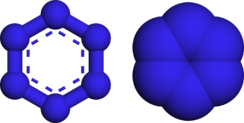Chemistry:Hexazine

| |

| |
| Names | |
|---|---|
| Preferred IUPAC name
Hexazine (preselected name) | |
| Systematic IUPAC name
Hexaazabenzene | |
| Other names | |
| Identifiers | |
3D model (JSmol)
|
|
| ChEBI | |
| ChemSpider | |
| 1819 | |
PubChem CID
|
|
| |
| |
| Properties | |
| N6 | |
| Molar mass | 84.042 g·mol−1 |
Except where otherwise noted, data are given for materials in their standard state (at 25 °C [77 °F], 100 kPa). | |
| Infobox references | |
Hexazine (also known as hexaazabenzene) is a hypothetical allotrope of nitrogen composed of 6 nitrogen atoms arranged in a ring-like structure analogous to that of benzene. As a neutrally charged species, it would be the final member of the azabenzene (azine) series, in which all of the methine groups of the benzene molecule have been replaced with nitrogen atoms. The two last members of this series, hexazine and pentazine, have not been observed, although all other members of the azine series have (such as pyridine, pyrimidine, pyridazine, pyrazine, triazines, and tetrazines).
While a neutrally charged hexazine species has not yet been synthesized, two negatively charged variants, [N6]2-[2] and [N6]4-,[3] have been produced in potassium-nitrogen compounds under very high pressures (> 40 GPa) and temperatures (> 2000 K). In particular, [N6]4- is aromatic, respecting Hückel's rule, while [N6]2- is anti-aromatic.
Stability
The hexazine molecule bears a structural similarity to the very stable benzene molecule. Like benzene, it has been calculated that hexazine is likely an aromatic molecule. Despite this, it has yet to be synthesized. Additionally, it has been predicted computationally that the hexazine molecule is highly unstable, possibly due to the lone pairs on the nitrogen atoms, which may repel each other electrostatically and/or cause electron-donation to sigma antibonding orbitals. A figure-8-shaped isomer is predicted to be metastable.[4]
See also
- 6-membered rings with other numbers of nitrogen atoms: pyridines, diazines, triazines, tetrazines, and (like hexazine, theoretical) pentazines
- Azide
- Pentazole (HN5)
- Other molecular allotropes of nitrogen: tetranitrogen (N4), octaazacubane (N8)
- Other inorganic benzene analogues: borazine, hexaphosphabenzene
References
- ↑ "Hexazine - PubChem Public Chemical Database". The PubChem Project. USA: National Center for Biotechnology Information. https://pubchem.ncbi.nlm.nih.gov/summary/summary.cgi?cid=11966278&loc=ec_rcs.
- ↑ Wang, Yu; Bykov, Maxim; Chepkasov, Ilya; Samtsevich, Artem; Bykova, Elena; Zhang, Xiao; Jiang, Shu-qing; Greenberg, Eran et al. (July 2022). "Stabilization of hexazine rings in potassium polynitride at high pressure" (in en). Nature Chemistry 14 (7): 794–800. doi:10.1038/s41557-022-00925-0. ISSN 1755-4330. PMID 35449217. Bibcode: 2022NatCh..14..794W. https://www.nature.com/articles/s41557-022-00925-0.
- ↑ Laniel, Dominique; Trybel, Florian; Yin, Yuqing; Fedotenko, Timofey; Khandarkhaeva, Saiana; Aslandukov, Andrey; Aprilis, Georgios; Abrikosov, Alexei I. et al. (2023-03-06). "Aromatic hexazine [N64− anion featured in the complex structure of the high-pressure potassium nitrogen compound K9N56"] (in en). Nature Chemistry 15 (5): 641–646. doi:10.1038/s41557-023-01148-7. ISSN 1755-4349. PMID 36879075. Bibcode: 2023NatCh..15..641L. https://www.nature.com/articles/s41557-023-01148-7.
- ↑ J. Fabian and E. Lewars (2004). "Azabenzenes (azines) — The nitrogen derivatives of benzene with one to six N atoms: Stability, homodesmotic stabilization energy, electron distribution, and magnetic ring current; a computational study". Canadian Journal of Chemistry 82 (1): 50–69. doi:10.1139/v03-178. Archived from the original on 2005-03-29. https://web.archive.org/web/20050329185413/http://pubs.nrc-cnrc.gc.ca/rp/rppdf/v03-178.pdf.
Further reading
- P. Saxe and H. F. Schaefer III (1983). "Cyclic D6h Hexaazabenzene-A Relative Minimum on the N6 Potential Energy Hypersurface?". Journal of the American Chemical Society 105 (7): 1760–1764. doi:10.1021/ja00345a010.
- H. Huber (1982). "Is Hexazine Stable?". Angewandte Chemie International Edition 21 (1): 64–65. doi:10.1002/anie.198200641.
- M. N. Glukhovtsev and P. von Ragué Schleyer (1992). "Structures, bonding and energies of N[6] isomers". Chemical Physics Letters 198 (6): 547–554. doi:10.1016/0009-2614(92)85029-A. Bibcode: 1992CPL...198..547G.
- T.-K. Ha, R. Cimiraglia and M.T. Nguyen (1981). "Can hexazine (N6) be stable?". Chemical Physics Letters 83 (2): 317–319. doi:10.1016/0009-2614(81)85471-1. Bibcode: 1981CPL....83..317H.
External links
 |

